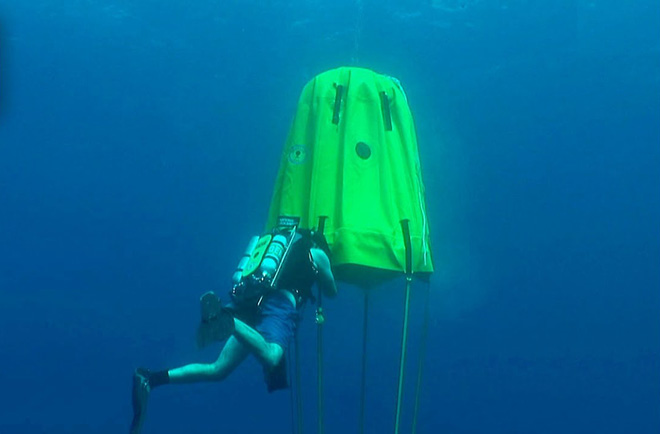Your Next Dive Safety Device Might Be . . . an Underwater Tent?Contents of this Issue: Kona Aggressor II, Kona, Hawaii Strobes Don’t Damage the Marine Life Should You Let the “Dentists of the Sea” Clean Your Teeth? Scubaqua, St. Eustatius, Dutch Caribbean Do These So-Called Shark Repellants Keep Sharks at Bay? The Fatal Effects of “Rapture of the Deep” Can a Fish Tell If a Scuba Diver Is Armed? Is Menopause a Cause of the Bends? Is Your Old Computer Still Safe? Your Next Dive Safety Device Might Be . . . an Underwater Tent? Shark Fins Are Banned in 12 U.S. States -- But It’s Still on the Menu Editorial Office: Ben Davison Publisher and Editor Undercurrent 3020 Bridgeway, Suite 102 Sausalito, CA 94965 from the March, 2019 issue of Undercurrent
Some divers can't stop trying new ways to go deeper and stay there longer. The latest gadget: An inflatable underwater tent with its own gas supply. Michael Lombardi, a National Geographic Society explorer, and Winslow Burleston, a professor at New York University, have come up the Ocean Space Habitat, an underwater tent reminiscent of a very large diver's lifting bag. It serves as a portable lifesupport system for divers who need long decompression periods before going to the surface. Aristotle, the Greek scientist and philosopher, probably was the first one who came up the idea of a diving bell -- around 350 B.C., he suggested sinking an inverted cauldron to trap air inside so that breath-holding underwater swimmers could surface and breathe freely. Some intrepid deep cave divers have experimented with similar items, such as upturned submerged dumpsters and cattle troughs, to make long decompression stops in more comfort and relax while breathing the oxygen-rich gas needed for faster decompression. After the National Oceanic and Atmospheric Administration shut down its last permanent underwater habitat, Lombardi was awarded a grant to try out a new concept. Several divers at a time can swim into the Ocean Space Habitat, remove their equipment (hanging their scuba tanks off the sides of the tent's exterior), talk, eat, process samples and even sleep through the decompression process, because the air inside the securely anchored dry chamber remains at the same pressure as the water surrounding it. Could the Ocean Space Habitat also be an answer to the dive industry's hesitation about in-water emergency recompression? Maybe liveaboards in remote locations would find this something worth investing in for such diving emergencies and supplying it with therapeutic oxygen or enriched air. Despite the fact that the Habitat's creators designed it to be lightweight and portable enough to travel with as checked luggage, we calculate it would need around two tons of ballast to be neutrally buoyant. And while Burleson told National Geographic that diving with the Habitat is like "turning a short hike in the woods into a weekend-long camping excursion," we say no, do not plan for a weekend-long camping trip underwater. |

I want to get all the stories! Tell me how I can become an Undercurrent Online Member and get online access to all the articles of Undercurrent as well as thousands of first hand reports on dive operations world-wide
| Home | Online Members Area | My Account |
Login
|
Join
|
| Travel Index |
Dive Resort & Liveaboard Reviews
|
Featured Reports
|
Recent
Issues
|
Back Issues
|
|
Dive Gear
Index
|
Health/Safety Index
|
Environment & Misc.
Index
|
Seasonal Planner
|
Blogs
|
Free Articles
|
Book Picks
|
News
|
|
Special Offers
|
RSS
|
FAQ
|
About Us
|
Contact Us
|
Links
|
3020 Bridgeway, Ste 102, Sausalito, Ca 94965
All rights reserved.


